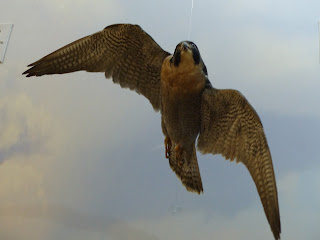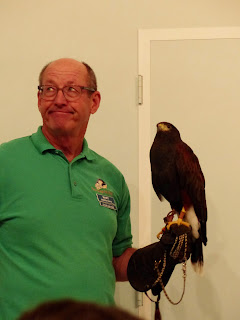 Since we'd already taken a little stroll on the Mossy Cave Trail, George wasn't thrilled about going somewhere else today. I still wanted to go to Kodachrome Basin State Park--and it was only another 15 miles.
Since we'd already taken a little stroll on the Mossy Cave Trail, George wasn't thrilled about going somewhere else today. I still wanted to go to Kodachrome Basin State Park--and it was only another 15 miles.Kodachrome Basin was named in 1948 by a National Geographic Society Expedition in honor of the then revolutionary Kodak film that was celebrated for its color accuracy. Now the cameras (and phones) are all digital and a lot of people only know about Kodachrome from the old Paul Simon song.
In a state with unusual geographical formations, the rocks here are....well....unusual. There are more than 60 upright cylindrical chimneys called "sand pipes", ranging from 6' to 170' in height.
There are several theories about how these pipes were formed, which basically comes down to "the geologists don't have a clue". I always want to know stuff like this, but "nobody knows" works for me too.
I couldn't talk George into hiking the 3-mile long Panorama Trail, but he agreed to drive up to the end of the road to see more formations. Eagle's View Trail starts here, but it's closed. (Since it was closed because of erosion in 2010, I should probably have said "still closed". Don't know why it's even listed in the park guide, but perhaps someone is optimistic that they will eventually rebuild the part that fell off or it will fix itself.)
It was easy to talk him into Angel's Palace Trail. Longer than Eagle's View (1.5 miles instead of .5) but not as steep (150' elevation gain instead of 500'), it's ADA accessible. I figured George could handle that, even though we were over a mile high. Sometimes higher elevation makes it hard for him to hike. Parking is next to the campground.
...as well as some great views of Kodachrome Basin.
We got to the end of the trail...sort of. Neither of was willing to walk all the way out onto this fin. There's no guard rails and it's nowhere near wide enough for me! I like the view from here, thank you very much.
After we finished the loop and got back to the truck, we took a little drive through the campground. It's a really nice one, with spacious sites, and about a third have power. George said he'd be willing to stay here sometime, even without full hookups. (Yahoo!!! I'm thinking one year when we go south for the winter, we can go to Moab again, then pick up Hwy. 12 at Torrey. That'll give us the rest of the Scenic Byway and more country we haven't seen yet. I'll plan in advance and make reservations at the campground.)
A few more pictures of Kodachrome Basin State Park































































